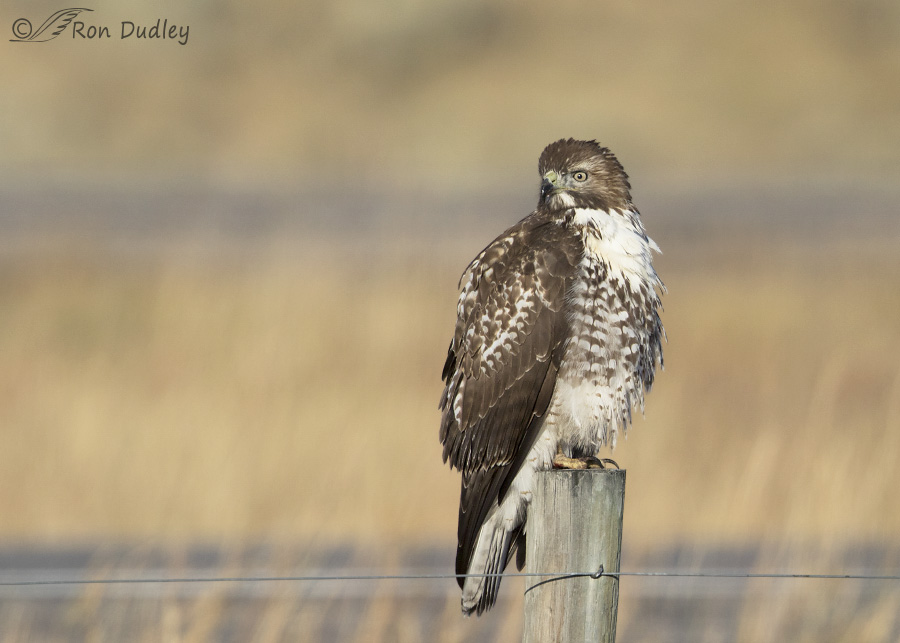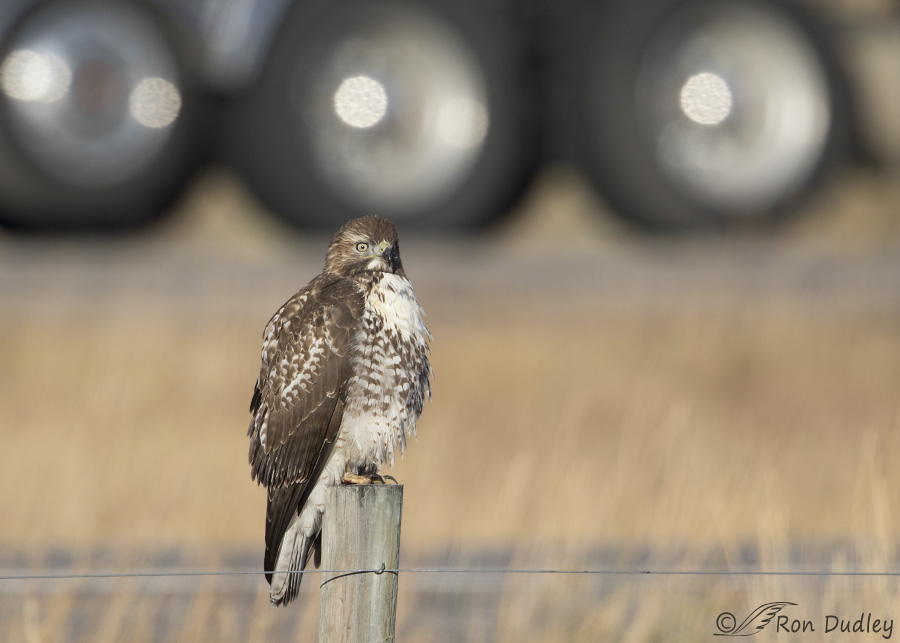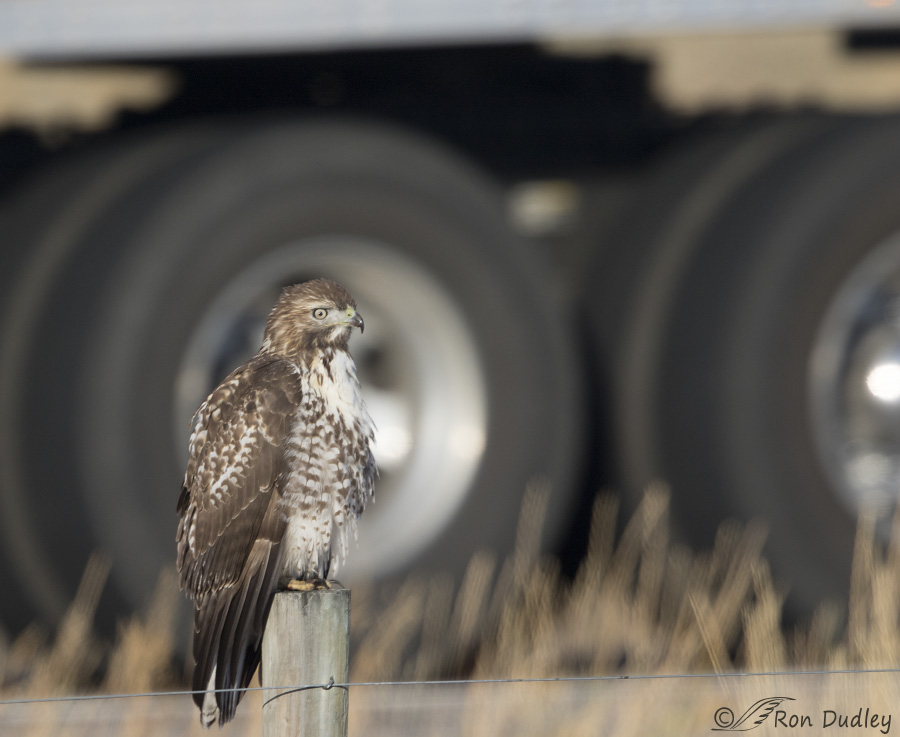Some Red-tailed Hawks become quite tolerant of human activities but for me this one stood out.
 1/3200, f/6.3, ISO 500, Canon 7D Mark II, Canon EF 500mm f/4L IS II USM + EF 1.4 III Extender, not baited, set up or called in
1/3200, f/6.3, ISO 500, Canon 7D Mark II, Canon EF 500mm f/4L IS II USM + EF 1.4 III Extender, not baited, set up or called in
I photographed the young bird last week near the continental divide between Montana and Idaho as it hunted from a fence post. One of the things I enjoy about photographing birds in this area is the vast wide-open spaces in wild country that often allow me to get bird images that don’t include unnatural elements – signs of the “hand of man”. But Red-tailed Hawks are “sit and wait” hunters that prefer to sit on elevated perches like fence posts and power poles and that tendency often stymies my efforts for natural images. But I’ve learned to tolerate fence posts in my images because of the relatively low angle and there’s less chance of getting obtrusive wires in my photos than there is with power poles.
But there’s something else unnatural in the image – those two horizontal darker lines going through the image at top and bottom. Any guesses as to what they are?

1/2000, f/6.3, ISO 500, Canon 7D Mark II, Canon EF 500mm f/4L IS II USM + EF 1.4 III Extender, not baited, set up or called in
They’re the north and southbound lanes of Interstate 15!
This bird was hunting amazingly close to the freeway and even though there’s little traffic that time of morning (often a full minute or two goes by between vehicles) this bird wasn’t even phased by the occasional noisy truck. In this case it’s an 18-wheeler traveling at 75 mph (they all go that fast or faster in this area) so it made a lot of noise but the bird paid it no attention.
But you ain’t seen nuthin’ yet! This big rig was in the far southbound lane…

1/1250, f/6.3, ISO 500, Canon 7D Mark II, Canon EF 500mm f/4L IS II USM + EF 1.4 III Extender, not baited, set up or called in
but the hawk didn’t even flinch when one of these huge noisy trucks came by in the closer northbound lane. The noise, commotion and air blast when one or more of these big rigs comes by are intense and I was surprised the hawk was willing to put up with it at such close proximity. I know I wouldn’t be able to (I was significantly further away and shooting with a super-telephoto lens).
Photographers might want to take note of the fairly dramatic drop in shutter speed in the last two images as more and more of the background became dominated by the dark truck tires and shadows. That’s just one of those things that happens when you shoot in aperture priority.
I figure there’s several reasons why this bird was so tolerant:
- the hawk was a juvenile and young birds are less skittish than adults
- Red-tailed Hawks are more tolerant than many other buteo species just by the nature of the bird
- the fence post provided an elevated hunting perch and the post was close to the freeway
- red-tails hunt where there’s prey and there must have been plenty of voles this close to the road
In this human-dominated world species that can adapt to the presence of man tend to thrive (house sparrows, starlings, foxes, coyotes, skunks and many others come to mind) while those that cannot adapt tend to end up on endangered or threatened species lists.
I’m glad that Red-tailed Hawks are in the former group because they seem to be holding their own.
Ron
PS – I can’t resist sharing one of my images of a Rough-legged Hawk that has been published in the current issue of Audubon Magazine. It’s one of my favorite raptor photos largely because I love the bird’s in-flight posture. The image illustrates an article that provides tips for photographing raptors in flight. I’m not sure I agree with all of those tips but then bird photographers are notorious for having their own ways of doing things…


Shot in AUDUBON is AMAZING!!! Shots of bird this close to busy highway is scary….
Thanks, Patty. And agreed…
How exciting Ron and congratulations on getting you photo on the cover of Audobon. That is such a great photo. I get Audobon and now I can’t wait until it comes. You are famous!
Thanks, Debbie. Infamous is more like it but I’ve been that for a long time…:)
That is an amazing image in Audubon Magazine.
Hearty and deserved congratulations.
I am so grateful to have found you. Daily awe, wonder and learning.
Years back we were driving into town and spotted a Wedge-Tailed Eagle perched on a road kill kangaroo. How I wish we had cameras with us, despite the image being engraved on our hearts.
And how I cringe at the birds/animals which hunt along the highways. Necessity can be a dangerous road to travel.
Yep, it’s dangerous for them to hunt near the roads. We saw another road killed owl (don’t know what species) on this last camping trip. I’m glad you like the Audubon image, EC. Thank you.
Oh my gosh !! Your rough legged hawk in flight is my dream picture……. Someday.. Yes I worry about hawks and highways!!there was a dead rabbit in middle of road and two northern harriers were fighting over it. The trucks just came flying by without slowing down . and the harriers would wait till almost a split second before they would get hit. Finally they had such a close call I retrieved rabbit and moved him off road.
Good for you for moving the rabbit, Marina. I’m glad you like the roughie, thanks.
Hi Ron. See Audubon got some tips from you on how to rest your arm and keep your camera still. And a great photo as well.. But all of us who read your blog just expect that Thanks Diana
Yeah, they did that too, Diana. Thank you.
It’s interesting to learn the Red-tails are “sit and wait” hunters, because we’ve been watching a couple of juveniles at Hueco Tanks, and they seem to always be circling with the Turkey Vultures. It’s pretty amazing that the bird you were watching was so tolerant of the traffic, but I’m glad that it has found a way to do well. The Audubon image is wonderful. The flight posture seems unusual to me, but I’m sure they achieve postures like that during flight that we see only when the camera stops the flight.
Susan, red-tails also hunt from the air especially when there’s updrafts but most often they’ll hunt from elevated perches when they’re available.
That particular flight posture of the Rough-legged Hawk was because the bird was kiting low next to the road along the Antelope Island causeway and occasionally it would assume this raised-head/bent body posture in order to look over to the other side of the elevated road.
The shot in Audubon is definitely top notch. Congratulations! Maybe the red tail was so used to the commotion of the big rigs your presence didn’t bother him/her. The comparison of shutter speed variations is an excellent example of shooting in AV mode when background lighting changes and why some espouse using manual under similar conditions. Again, love the Audubon shot. Excellent!
Frank, with everything going on near this bird I’m not sure it paid any more attention to me than it did the strands of blowing grass. It seemed only intent on potential prey.
Oh yes, that’s another Oh WOW (insert string of superlatives here). What a lovely juvie, but y’all know I’m easy with redtails (raptors, birds, overall critters).
I have to admit that I always cringe when I see a raptor hunting alongside a highway. Yes, I know there are tasty critters there, and they tend to be the ones that are easy to catch, which is a survival thing, but GADS, it’s oh so dangerous for them. And the fact that they’re nonplussed by the sounds/sights of traffic going by also makes them oblivious to the danger (combined with the idea that they have no idea about the dangers humans put in their paths). But as long as survival strategies are what they are…
And let me add another Oh WOW (plus superlatives) for your rough-legged hawk image in Audubon magazine! YAY for YOU!!
Dick Harlow, I had the same experience with a Cooper’s hawk when I lived in Dallas. It was chasing a dove and the dove used me as a chicane/blind. The Cooper’s took a nanosecond to shoot me a quick stink eye just for being there before she made the zig to catch the dove on the zag. I was gardening that day and of course didn’t have my camera. Wouldn’t have done any good if I’d had it because while I have many skills, photography is not among them!
As for (photographic) shooting styles, I’d submit that individual photographers repeat what works (or has worked) for them, just like the redtails (raptors/other critters). If a strategy works, you’re far more likely to try to repeat it and there are always different paths to excellence. Again, we’re far more alike than we are different.
“I’d submit that individual photographers repeat what works (or has worked) for them, just like the redtails (raptors/other critters). If a strategy works, you’re far more likely to try to repeat it”
That’s a perfect analogy, Laura. Thank you.
Congratulations, Ron, on the Audubon photo. That’s top of the line.
Thanks very much, Larry.
Wonderful Ron!
charlotte
Thanks, Charlotte.
Beautiful photo of the Rough-legged Hawk, Ron. Wish I got to see them more frequently. Congratulations on being published in both Audubon and the new Cornell text!
Thanks, Diane. We were mentioning just two days ago how much we’re looking forward to the return of Rough-legged Hawks for the winter.
All I can say is WOW!! Wonderment of the ability of the Red-tail to deal with the noise and the passing heavy traffic, certainly understandable if there is plenty of voles around.
Where i am in VT Red-tails, for that matter all hawks are skittish when people appear. However, I was lucky to take a picture of an arrogant, immature Cooper’s flying directly at me a foot off the ground, but had to do it through a window and screen. He/she seemed to be terribly upset at missing a Mourning Dove and yet its inexperience still led it to investigate our garden and shrubs.
Congratulations on the picture in Audubon – that is quite a shot!!
Wow, I’m impressed, Dick. Locking focus on a bird coming at you in flight and through a window (and screen) is one challenging maneuver!
Well, I wouldn’t generally do this, but sent you two pics.
All I can say is I didn’t expect to get the flying shot, it was the only one that came out that was OK along with a couple of standing ones.
Dick, that might be the only raptor flight shot I’ve ever seen that was taken through both a window and a screen. The impossible can be done!
Thanks, that means a lot.
Great example of the difference aperture and shutter speed can make in getting rid of unwanted items as well as accentuating the subject! Congrats on the beautiful photo in Audubon Magazine – interesting article with it. May have to try that!
Congrats on the beautiful photo in Audubon Magazine – interesting article with it. May have to try that! 
Judy, In the article I think their tip to use high shutter speeds for birds in flight is a good one (regular readers know that’s something I always do when I can). However, suggesting that we use “the fastest shutter speed possible” may be going just a little too far. There’s also the depth of field issue to consider, especially if you’re relatively close to the bird.
That’s true – the following the bird above the camera is what interested me – at least in certain situations!
“following the bird above the camera is what interested me”
Judy, it’s interesting how individual shooting styles evolve. I think their suggestion that beginners learn to line up the hot shoe with the end of the lens is a good one. But for me I aim down the left side of the barrel of the lens which is a technique I’ve developed a good feel for. I think I first learned it with rifles and particularly shotguns as a kid…
I’ll have to try that too as following through the view finder is quickly tiring for me. Thx
May have to modify that – I’m guess you are right eyed and I’m left eyed (right handed – a bit of a hassle at times)
Judy, I don’t think I explained myself very well. Let me clarify.
When I said I aim down the left side of the barrel that’s just to get the bird somewhere in my viewfinder or close (when it works). As soon as I’ve done that I quickly go to actually looking through my viewfinder before I take the shots(s). You have to be unbelievably lucky (an understatement) to get the bird in the frame, much less sharp, without looking through the viewfinder.
I understood one needs to use the viewfinder and this was to get “close” The close before going to the view finder helps immensely!
The close before going to the view finder helps immensely!  Thx
Thx
Hello Ron, I was elated to notice the “Barbless Wire” stapled to the post, I’m assuming the top strand. A good and compassionate consideration to wildlife in flight and on legs (Ungulates) who cannot completely clear jump a barrier fence. Your observation of the ignored “big rig” close by is a common sight for those of us who have driven these big rigs in the past. I had an experience with a TOM Turkey, while driving an 18 wheeler, in PA years ago, that stood just inches from the pavement on the berm as I drove past it. I was sure the wind side blast would knock it over-but it didn’t; as the side blast was easily noted in the side mirror ruffling it’s feathers—yet it stood it’s ground. Sorry to say they are often killed in flight crossing the highways–and will be harmful to vehicle occupants as they are known to go thru the windshield because of their weight and size. White Tailed Deer, here in the East, are the same as sometimes being oblivious to highway traffic close by—especially during Fall Rut! Don
Don, I once hit a male Ring-necked Pheasant while driving the largest U-Haul truck available. It glanced off the frame of the windshield and wedged in-between the passenger side mirror and its frame, breaking the mirror, bending the frame and of course killing the pheasant in the process. I couldn’t get off the busy freeway to retrieve the pheasant because I didn’t dare change lanes to my right without use of my mirror so I drove all the way to my destination (about a half hour) in the same lane with the pheasant stuck in the mirror frame.
I was sure U-Haul was going to charge me for the damage but when I returned the truck to them I left the bird in place to prove what happened. Turns out the guys at U-Haul were all fly fishermen and they were so delighted to get those tail feathers for tying flies they let me off the hook (pun intended…).
The flyfishing story made me giggle. I once hit a Great White Heron in Louisiana. It had cleared the 18 Wheeler on my right but I didn’t see it nor it me in time. I cried all the way to work.
But a happier story! This weekend I was on Whidbey Island in Washington state. I walked outside and heard a high pitched cheep (seriously…it sounded like a cheep.) I looked up to see a huge Osprey flying in towards me. I watched it join up with what I thought was another osprey but then there were a total of four others with it. We think it must have been a family unit but none of us had binoculars to really see. I thought of you though.
You may be right about it being a family, Arwen. I wish I had more opportunities with Ospreys than I do…
Beautiful image in Audubon Magazine Ron. Congratulations !
Thanks very much, John.